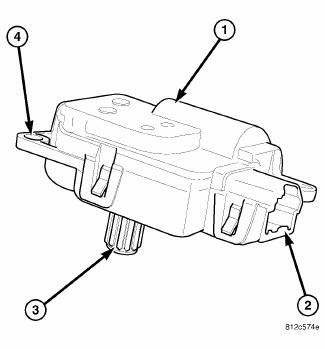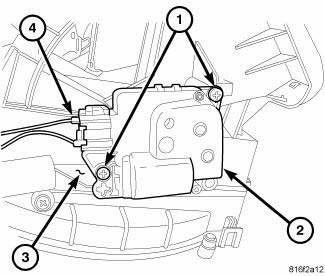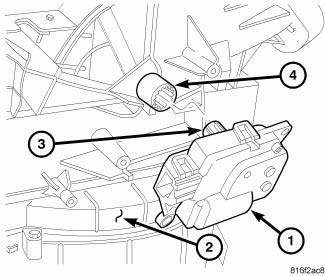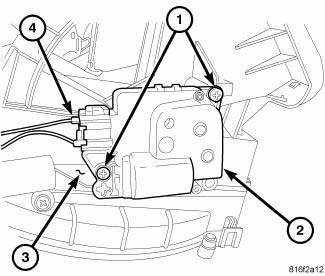Dodge Journey: Actuator, recirculation door
DESCRIPTION

Fig. 15: Blend Door Actuators
The recirculation door actuator (1) is a reversible, 12 volt direct current (DC) servo motor, which is connected directly to the pivot shaft lever of the recirculation-air door. The recirculation door actuator is located on the right side of the HVAC air inlet housing.
The recirculation door actuator is contained within a black molded plastic housing with an integral wire connector receptacle (2), an output shaft with splines (3) connect it to the recirculation door and three integral mounting tabs (4) allow the actuator to be secured to the air inlet housing. The recirculation door actuator does not require mechanical indexing to the recirculation-air door, as it is electronically calibrated by the A/C-heater control.
The A/C-heater control must be recalibrated each time an actuator motor is replaced.
The recirculation door actuator is interchangeable with the actuators for the blend and mode-air doors.
OPERATION
The recirculation door actuator is connected to the A/C-heater control through the vehicle electrical system by a dedicated two-wire lead and connector of the instrument panel wire harness. The recirculation door actuator can move the recirculation-air door in two directions. When the A/C-heater control pulls the voltage on one side of the motor connection high and the other connection low, the recirculation-air door will move in one direction.
When the A/C-heater control reverses the polarity of the voltage to the motor, the recirculation-air door moves in the opposite direction. Once the A/C-heater control makes the voltage to both connections high or both connections low, the recirculation-air door stops and will not move.
The A/C-heater control uses a pulse-count positioning system to monitor the operation and relative position of the recirculation door actuator and the recirculation-air door. The A/C-heater control learns the recirculation-air door stop positions during the calibration procedure and will store a diagnostic trouble code (DTC) for any problems it detects in the recirculation door actuator circuits.
The recirculation door actuator cannot be adjusted or repaired and it must be replaced if inoperative or damaged.
REMOVAL
WARNING: Disable the airbag system before attempting any steering wheel, steering column or instrument panel component diagnosis or service. Disconnect and isolate the negative battery (ground) cable, then wait two minutes for the airbag system capacitor to discharge before performing further diagnosis or service. This is the only sure way to disable the airbag system. Failure to follow these instructions may result in accidental airbag deployment and possible serious or fatal injury.
NOTE: Illustration shown with instrument panel removed for clarity.

Fig. 16: Recirculation Door Actuator
NOTE: LHD model shown. RHD model similar.
1. Disconnect and isolate the negative battery cable.
2. Remove the glove box bin.
3. Reach through the glove box opening in the instrument panel and remove the screws (1) that secure the recirculation door actuator (2) to the right side of the HVAC air inlet housing (3).
4. Disconnect the wire harness connector (4) from the recirculation door actuator and remove the actuator.
INSTALLATION
NOTE: Illustrations shown with instrument panel removed for clarity.

Fig. 17: Recirculation Door Actuator-Align
NOTE: LHD model shown. RHD model similar.
1. Position the recirculation door actuator (1) to the right side of the HVAC air inlet housing (2).
2. Install the recirculation door actuator onto the air inlet housing. If necessary, rotate the actuator slightly to align the splines on the actuator output shaft (3) with those on the recirculation door pivot shaft adapter (4).

Fig. 18: Recirculation Door Actuator
3. Install the screws (1) that secure the recirculation door actuator (2) to the air inlet housing (3). Tighten the screws to 2 N.m (17 in. lbs.).
4. Connect the instrument panel wire harness connector (4) to the recirculation door actuator.
5. Install the glove box bin.
6. Reconnect the negative battery cable.
7. Initiate the Actuator Calibration function using a scan tool.
 Actuator, mode door, front
Actuator, mode door, front
DESCRIPTION
Fig. 12: Blend Door Actuators
The mode door actuator (1) for the heating-A/C system is a reversible,
12-volt Direct Current (DC) servo motor,
which is mechanically connected to the ...
See also:
Link, stabilizer bar
REMOVAL
1. Raise and support the vehicle.
Fig. 60: TIRE AND WHEEL MOUNTING
2. Remove the wheel mounting nuts (3), then the tire and wheel assembly (1).
Fig. 61: Strut Mounting To Knuckle
3. W ...
ALL WHEEL DRIVE (AWD) — IF EQUIPPED
This feature provides on-demand All-Wheel Drive
(AWD). The system is automatic with no driver inputs or
additional driving skills required. Under normal driving
conditions, the front wheels provide ...
Description, Operation
DESCRIPTION
Fig. 418: Identifying Ignition Key/Switch Positions
- LOCK
- ACC
- ON
- START
The Brake Transmission Shifter/Ignition Interlock (BTSI) is a solenoid
operated system that ...

